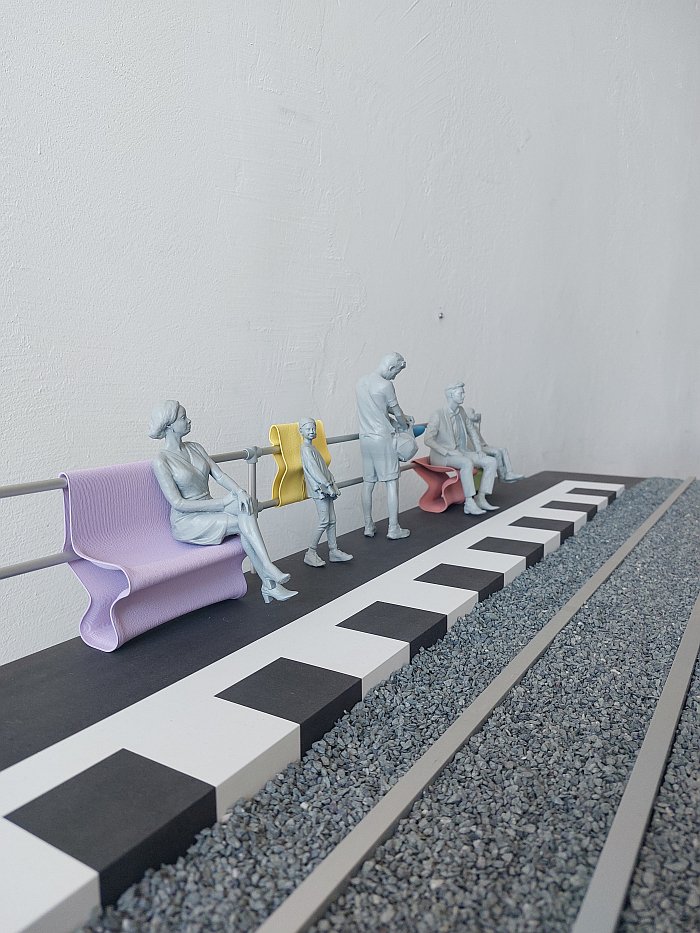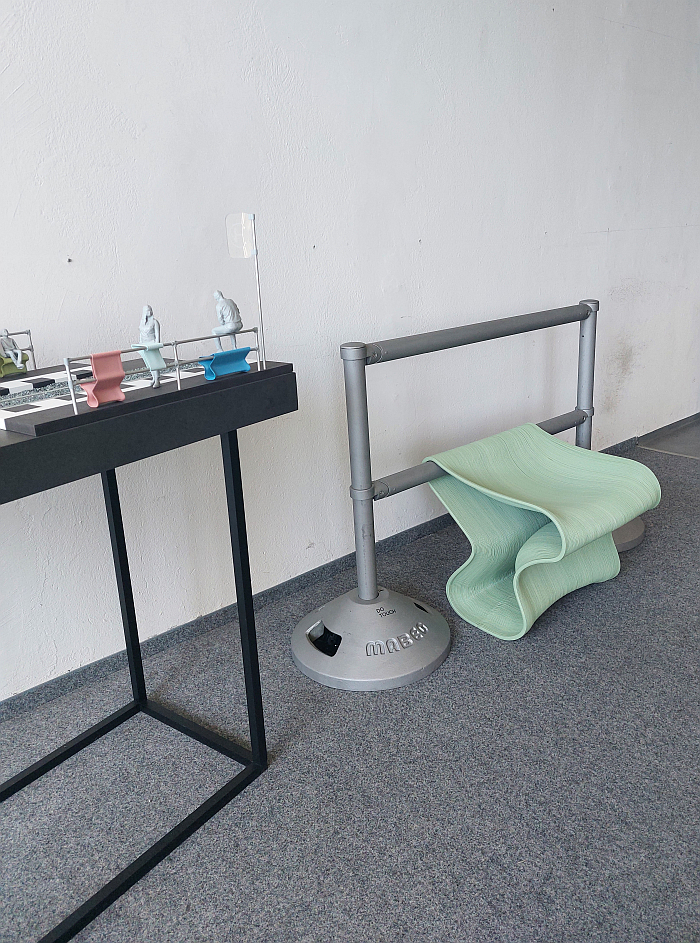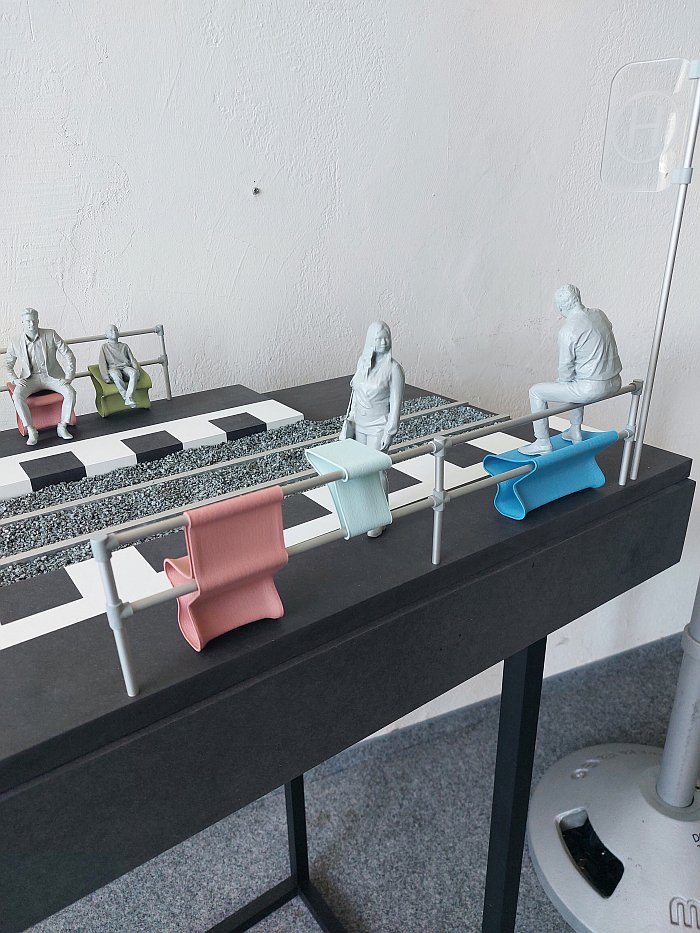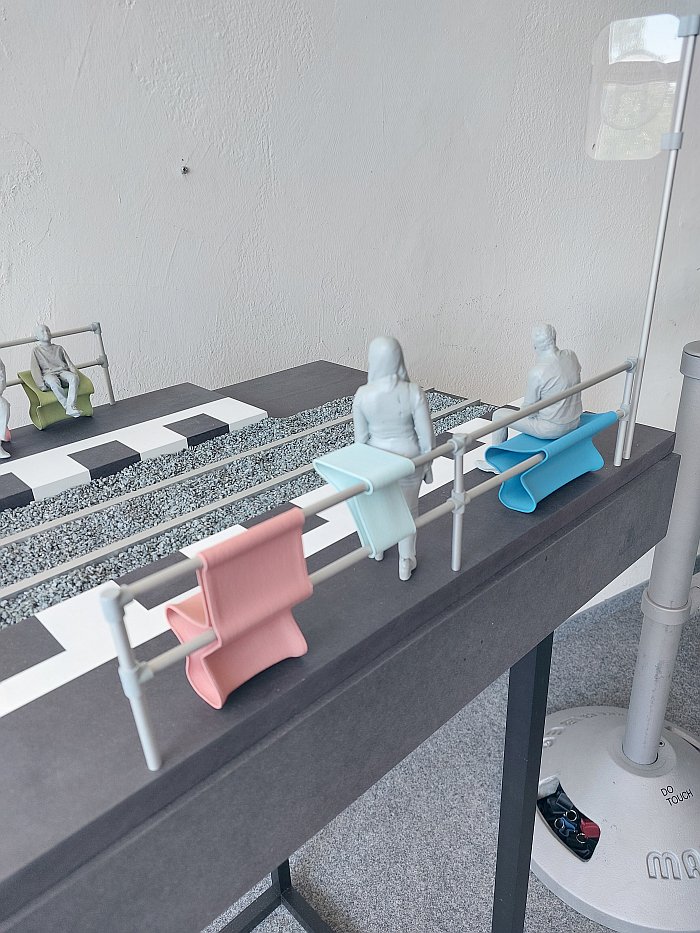
If we're going to entice and encourage ever more individuals in urban spaces to give up their private cars, and, we'll argue, that is desirable not only in terms of tackling the myriad problems of our contemporary urban spaces but also in exposing the fiction of, and the egoistic stupidity of, autonomous cars and flying taxis, we not only need public transport vehicles and networks that are inviting, affordable, clean, meaningful and reliable, but a public transport infrastructure responsive to both the needs of individuals out and about for a wide variety of personal, professional and social reasons and also responsive to the individual needs within that mass. And globally that infrastructure is lacking. Or how are things at your local bus/tram/train stop? Thought so.
Morari by Jesse Altmann, Valentina Lenk and Klara Schneider, a trio of design students at the Fachhochschule Potsdam, is a proposal to change that. And a very engaging and satisfying proposal at that.
For a number of reasons. Of which two are, for us, particularly noteworthy.
Firstly the variety of objects the Morari collection contains, single chairs, sofas, panels for leaning on and tables..... yes those tables that but rarely exist at transport stops despite us all, permanently, needing somewhere to put things down for a couple of minutes while we look for something in our bag, or check something on our phones, and whose absence invariably entails a dangerous juggling of coffees, phones, books and dog leads. The presence of tables in the Morari collection tending to confirm that Jesse, Valentina and Klara understand travelling by public transport, and understanding something is always a good starting point for designing for it.
Secondly the individual objects are 3D printed which on the one hand enables Jesse, Valentina and Klara to develop novel formal expressions, that thing novel technology not only always enables, but, as we all learn from the discourses of the early 20th century, novel formal expressions, and novel functionalities and novel relationships enabled by novel technology, designers must develop with novel technology. Specifically the trio have developed free-flowing, bulging, curving, dimension denying forms that, we imagine, through their contrast with the inevitable linear quadraticness of a public transport stop will help make any public transport stop a more inviting location, a more human, humane, location. In which context we'd also ask if they must be printed in plastics, would a wood based material be possible, for example the 3D printable cork based material developed by Weronika Wojnarowicz that can be viewed in context of Next: Young European Design at the Kunstgewerbemuseum Berlin? If so such would be a further very welcome softening of the brutality of the urban space through Morari.
And 3D printing that also means, and this is where it gets really interesting for us, you can establish decentralised production and supply systems: imagine, for example, if the BVG, the public transport supplier for Berlin, established a small 3D print workshop capable of producing Morari, they could then produce those units they needed, in the colours they needed, when they needed them. A real-time production and supply system which is sustainable, economic and responsive. We've not discussed this with Jesse, Valentina and/or Klara, but as a general rule designers of 3D printed furniture are only very rarely enamoured with our suggestion to make their designs components of a decentralised system, and it is a suggestion we make a lot. Just never to Dirk van der Kooij, because his work poses other questions. And a suggestion we make a lot not only because it often makes a lot of sense, but also for us it must be a key consideration in the wider questions of how we employ 3D printing technology, how we incorporate 3D printing technology into the production and supply of objects of daily use, and how we can make furniture distribution and supply more responsible. And as we all recall, in 1979 Hein Köster, the long-time editor of Form+Zweck, opined, in context of the decentralised production of the EW 1192 chair, that "distributing plans is cheaper than transporting finished products"1, and remains so. And also remains more sustainable. And always will remain so. And today the plans needn't be physically distributed, can stored in a cloud. And such a system doesn't mean designers not earning anything from their work, definitely doesn't; but does mean one needs to develop novel remuneration systems, and is there a designer out there who is happy with how contemporary licensing works? No. Is developing a sales and distribution network easy? No. So let's employ novel technology to not only develop novel formal expressions, novel functionalities and novel relationships but to develop novel remuneration systems in context of novel production and supply systems. Morari is an excellent example that alternatives are not only desirable but available. And tangible.
If tangible with a bit of work still to be done, Morari still has a few important questions to resolve, a few challenges to overcome; but as a project Morari is very engaging and satisfying and appealing, and as seating objects Morari, or certainly the Morari chair that we tried, offers a high level of not only seating comfort but seating security.
And although, yes, you do need bus or tram stops with railings to which to attach the objects — Morari is/are based in Potsdam which means the bus and tram stops often do, certainly those in the immediate vicinity of the Fachhochschule — in a great many cities globally bus and tram stops, certainly those in the middle of roads, tend to be separated from that road by simple two bar metal fences; it's a pretty universal approach which thus makes Morari a universal solution. There's that production and supply again. But Morari could also supply fences for towns and cities who don't have such and/or develop entire bus shelter concepts to house their furniture, possibly in partnership with one of those companies who provide bus shelters et al in order to have places to hang advertising. And perhaps also make money that way; make money from the supply of the infrastructure for the Morari furniture rather than from the Morari furniture per se. But, as ever, what do we know. Other than we hope Jesse, Valentina and Klara are able to develop their concept as far as they can and as they wish to. And also hope that before all too long the authorities realise that clean, inviting stops will encourage more people to use public transport.
Which, yes, is also, primarily, a responsibility of us all, a responsibility of us all not to turn public transport stops into rubbish tips. In which context the first time we viewed the presentation of Morari one of the model men occupying the model tram stop was sat on the top rail with his feet on the bench, which is obviously anti-social, later on he was sat on the bench like a civilised human being. Which is and was a very instructive sequence in context of how public furniture is used, abused. That thing we need to eradicate. As is the manspreading on display in the model tram stop: nice attention to detail, as noted above Jesse, Valentina and Klara understand travelling by public transport.
By way of completion, Morari was a prize winner in context of the Designpreis Brandenburg, one those great many regional design prizes that while their profile is often good locally, tend to get lost in a universe of design prizes. And which is a shame, because, as Morari ably demonstrates, regional prizes such as Designpreis Brandenburg often, regularly, shine a light on interesting, meaningful projects with a relevance and value far, far outwith the geographic borders of the prize.
Further details on Morari can be found at https://morari.design
Further details on Design Week Berlin can be found at https://berlindesignweek.com




1Hein Köster, Die Erste Jahre, Form+Zweck, Vol. 11, Nr. 5, 1979 page 19 (Available via https://digital.slub-dresden.de/werkansicht?id=5363&tx_dlf%5Bid%5D=131321&tx_dlf%5Bpage%5D=21 Accessed 05.05.2024 And as ever at this juncture a million and one thanks to the glorious people at the Sächsische Landesbibliothek – Staats- und Universitätsbibliothek, SLUB, Dresden for digitalising Form+Zweck as full text OCR and making them freely available.)